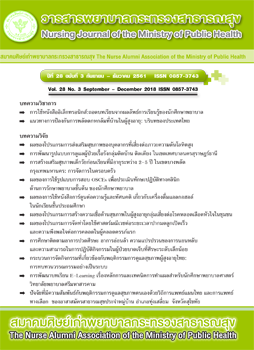A Longitudinal Study of Headache, Fatigue, Sleep Disturbance, and Performance in Patients with Mild Head Injury
Main Article Content
Abstract
This descriptive research aimed to explore and compare the occurrence of symptoms including headache, fatigue, sleep disturbance, and performance of patients with mild head injury at 24 hours, 1 month, 2 month, 3 month and 6 month after the injury. Fifty-nine patients were consecutively recruited by the inclusion criteria at a Trauma ward of Chon Buri Hospital during June 2016 to June 2017. Research instruments included the Personal Information questionnaire, the Brief Pain Inventory (BPI) questionnaire, the Barrow Neurological Institute (BNI) questionnaire, the Fatigue Scale, the Verran and Synder-Halpern Sleep Scale, and the Rivermead Head Injury Follow Up questionnaire (RHFUQ). Data were analyzed by using descriptive statistics, and Repeated Measures ANOVA. The results showed that at 24 hours, the 1st month, 2nd month, 3th month and 6th month after head injury, the samples reported having headache for
72.9 %, 51.3 %, 33.8 %, 24.2 %, and 16.9% respectively. The occurrence of fatigue were 95.1 %, 89.6 %, 77.5 %, 57.4 % and 64.4 % respectively, while 100% of samples reported that they had sleep disturbance all the time after head injury. Although the samples reported having no change in the level of their performance, they found that it was more difficult to perform activities of daily living by the 1st month, 2nd month, 3rd month and 6th month after the injury. The mean scores of the severity of headache, fatigue and sleep disturbance at 24 hours were significantly different (p < .001), from those in the 1st month, 2nd month, 3rd month and 6th month post injury. However, the mean score of the performance was not significantly different at all the time of the study. The findings reflect that nurses and health care providers should emphasize the issue of symptom occurrences including headache,
fatigue, and sleep disturbance in patients post minor head injury. Symptom assessment should be continuously performed in order to early manage any symptoms occurred in order to enhance performance among this population.
Article Details
บทความและรายงานวิจัยในวารสารพยาบาลกระทรวงสาธารณสุข เป็นความคิดเห็นของ ผู้เขียน มิใช่ของคณะผู้จัดทำ และมิใช่ความรับผิดชอบของสมาคมศิษย์เก่าพยาบาลกระทรวงสาธารณสุข ซึ่งสามารถนำไปอ้างอิงได้
References
2. Jagnoor J, Cameron I. Mild Traumatic brain injury and motor vehicle crashes: limitations to our understanding. [Internet]. 2014 [cited 2017 December 20]; Available from http://dx.doi.org/10.1016/j.injury.2014.08.044
3.Carr J. Postconcussion syndrome: a review. Trauma 2007;9(1):21-7.
4.Hawley C, Ward AB, Magnay A, Mychalkiw W. Return to school after brain injury. Archives of Disease in Childhood 2004;89(2):136-42.
5. Fourtassi M, Hajjioui A, Ouahabi AE, Benmassaoud, H, Hajjaj -Hassouni, N, Khamlichi, AE. Long term outcome following mild traumatic brain injury in Moroccan patients. Clinical Neurological and Neurosurgery 2011;113(9):716-20.
6. Stalnacke BM, Bjornstig U, Karlsson K, Sojka P. One-year follow-up of mild traumatic brain injury: Post-concussion symptoms, disabilities and life satisfaction in relation to serum levels of S-100B and neurone-specific enolase in acute phase. Journal Rehabilitation Medicine 2005;37:300-5.
7. Willer, B, Leddy JJ. Management of concussion and post - concussion syndrome. Current Treatment Options in Neurology 2006;8:415-26.
8. Lenz ER, Pugh LC, Milligan RA, Audrey G, Frederic S. The middle-range theory of unpleasant symptom: an update. Advance in Nursing Science 1997;19(3):14-27.
9. Hall Ryan CW, Hall Richard CW, Chapman MJ. Definition, diagnosis and forensic implications of postconcussional syndrome. Psychosomatics 2005;46(3):195-202.
10. Lundin A, de Boussard C, Edman G, Borg J. Symptoms and disability until 3months after mild TBI. Brain Injury 2006;20(8):799-806.
11. Meares S, Shores EA, Taylor AJ, Batchelor J, Bryant RA, Baguley IJ, et al. The prospective course of Post-concussion syndrome: The role of mild traumatic brain injury. Neuropsychology 2011;25(4):454-65.
12. Stulemeijer M, van der Werf SP, Bleijenberg G, Biert J, Brauer JMP, Vos PE. Recovery from mild traumatic brain injury: a focus on fatigue. Journal of Neurology 2006;253:1041-7.
13. Chong CS. Management strategies for post-concussion syndrome after mild head injury: a systematic review. Hong Kong Journal of Occupational Therapy 2008;18(2):59-67.
14. Orff HJ, Ayalon L, Drummond SPA. Traumatic brain injury and sleep disturbance: a review of current research. Journal Head Trauma Rehabilitation 2009;24:155-65.
15. Premsai, T. Follow up study of patients’ adaptation after mild head injury. [Thesis]. Bangkok Mahidol University; 2003. (in Thai).
16. Ariyawan W, Niphawan S, Khemaradee M. Relationships between headache, fatigue, sleep disturbance, and performance in mild head injury patients. Journal of Nursing and Health Care 2016;34(2):152-63. (in Thai).
17. De Kruijk JR, Leffers P, Menheere PPCA, Meerhoff S, Rutten J, Twijnstra A. Prediction of post-traumatic complaints after mild traumatic brain injury: early symptoms and biochemical markers. Journal Neurosurgery Psychiatry 2002;73:727-32.
18. Stevens JP. Applied multivariate statistics for the social sciences. USA: Lawrence Erlbaum Associates. 2002.
19. Kliangda R. Experiences of headache, management strategies and health-related quality of life in patients with mild traumatic brain injury. [Thesis]. Bangkok: Mahidol University; 2009.
20. Borgaro SR, Gierok S, Caples H, Kwasnica C. Fatigue after brain injury: initial reliability study of the BNI Fatigue Scale. Brain Injury 2004;18:685–90.
21. Jitpanya C. Conceptual and measurement of sleep. Journal of Nursing Science Chulalongkorn University 2000;12(1):1-9. (in Thai).
22. Deethongkham D. Relationship between post-concussion syndrome and functional performance in patients with mild traumatic brain injury. [Thesis]. Chonburi: Burapha University; 2015. (in Thai).
23. Browndyke JN. Mild head injury and posttraumatic headache. [Internet]. 2002 [Cited 2017 December 20]. Available from: http://bianj.org/Websites/bianj/images/Mildheadinjury andposttraumaticheadache.pdf.
24. Gupta G. Intracranial pressure monitoring [Internet]. 2015 [Cited 2017 December 22]; Available from: http://emedicine.medscape.com/article/1829950-overview#a1.
25. Norrie J, Heitger M, Leathem J, Anderson T, Jones R, Flett R. Mild traumatic brain injury and fatigue: a prospective longitudinal study. Brain Injury 2010;24(13-14):1528-38.
26. Mathias JL, Alvaro PK. Prevalence of sleep disturbances, disorders, and problems following traumatic brain injury: a meta-analysis. Sleep Medicine 2012;13(7):898-905.
27. Writghtson P, Gronwall D. Mild head injury: a guide to management. New York: Oxford University, Press. 1999.
28. Parcell DL, Ponsford JL, Redman JR, Rajaratnam SM. Poor sleep quality and changes in objectively recorded sleep after traumatic brain injury: a preliminary study. Archives of Physical Medicine and Rehabilitation 2008;89(5):843-850.

